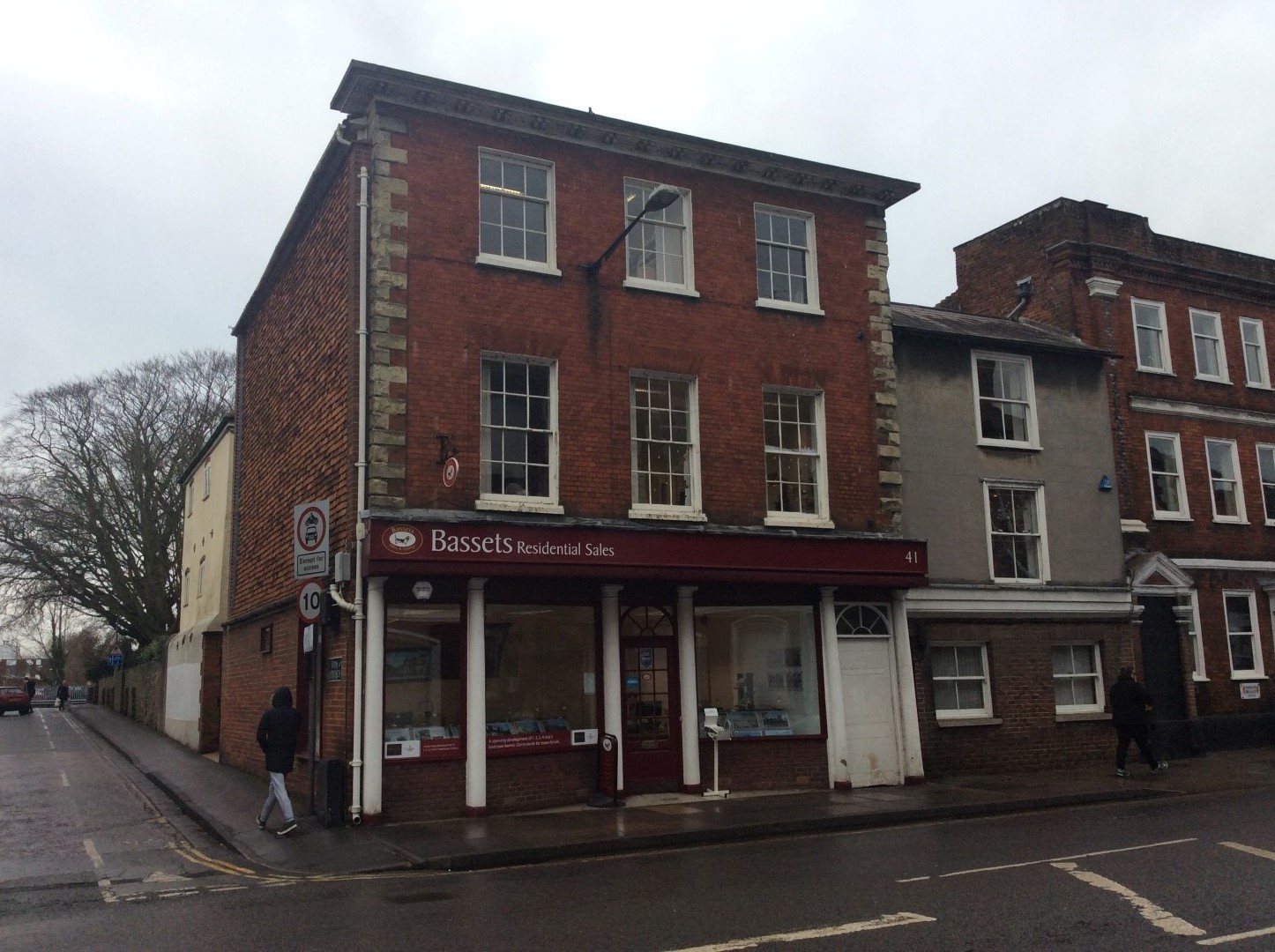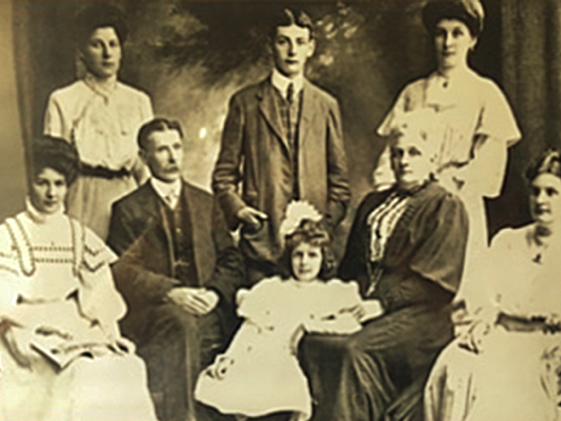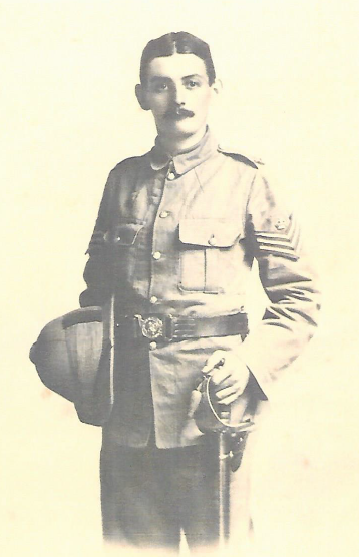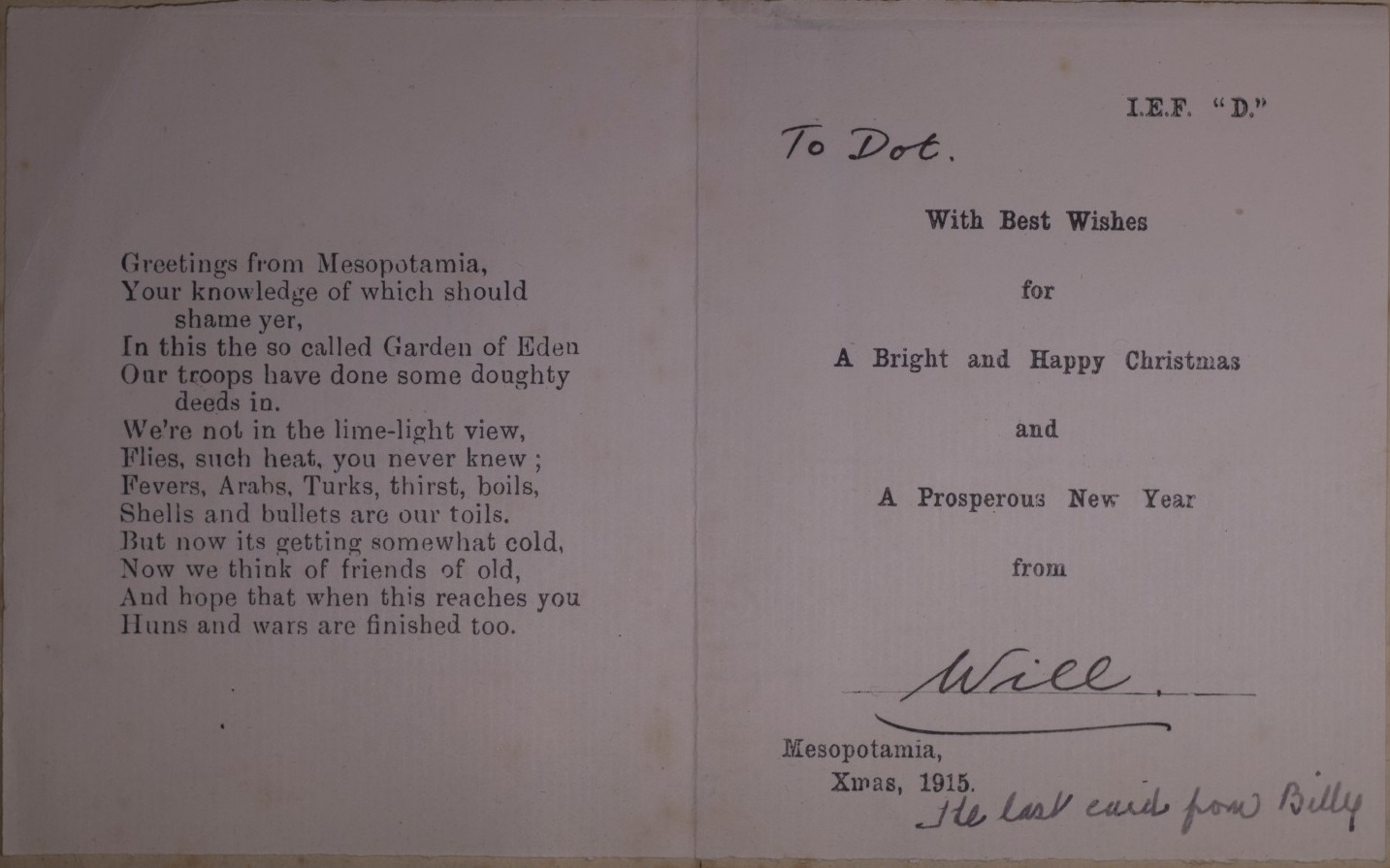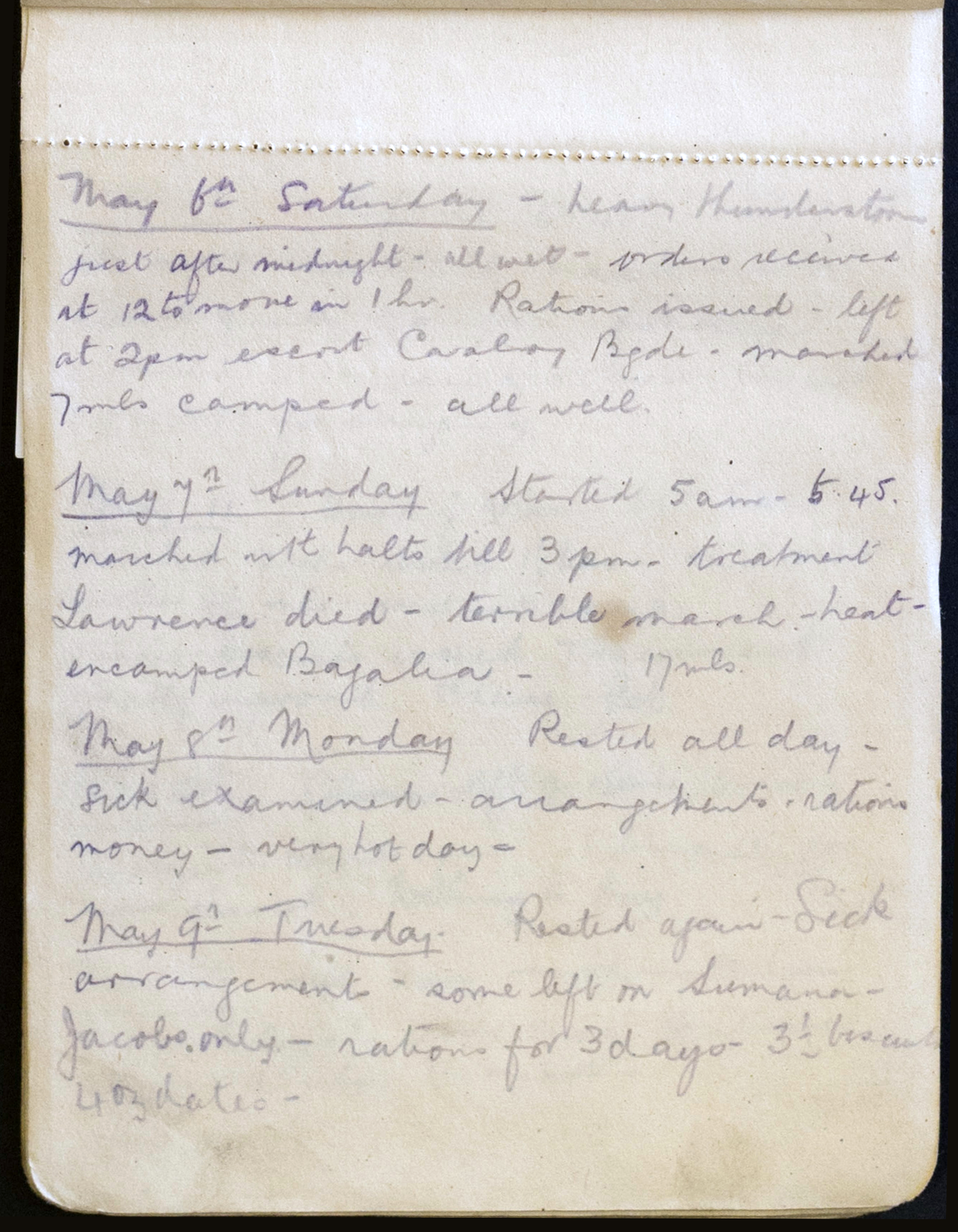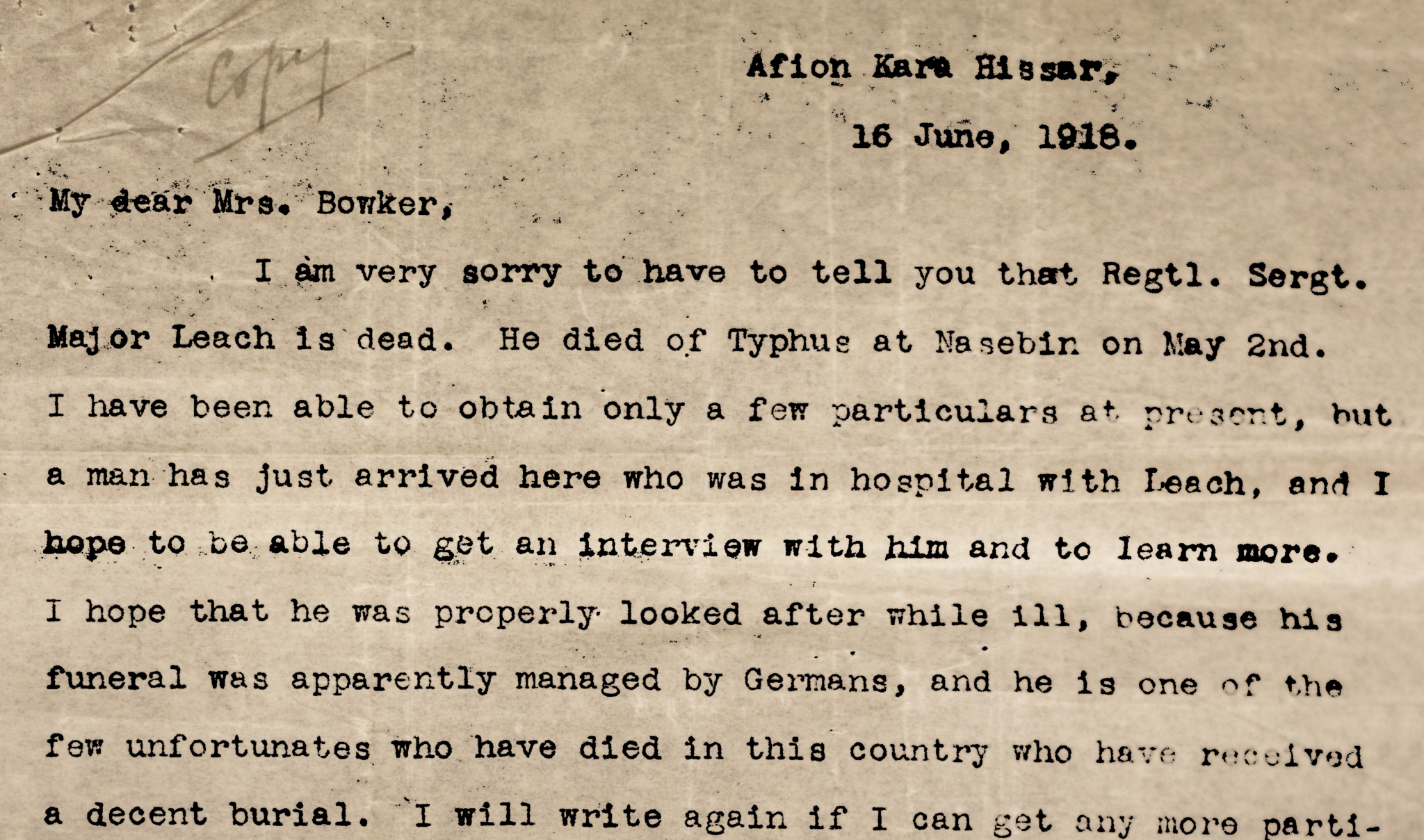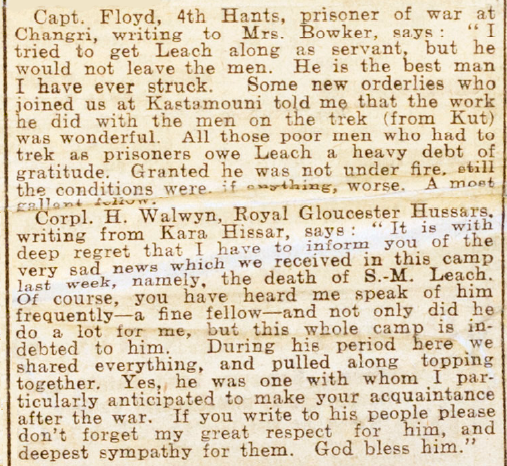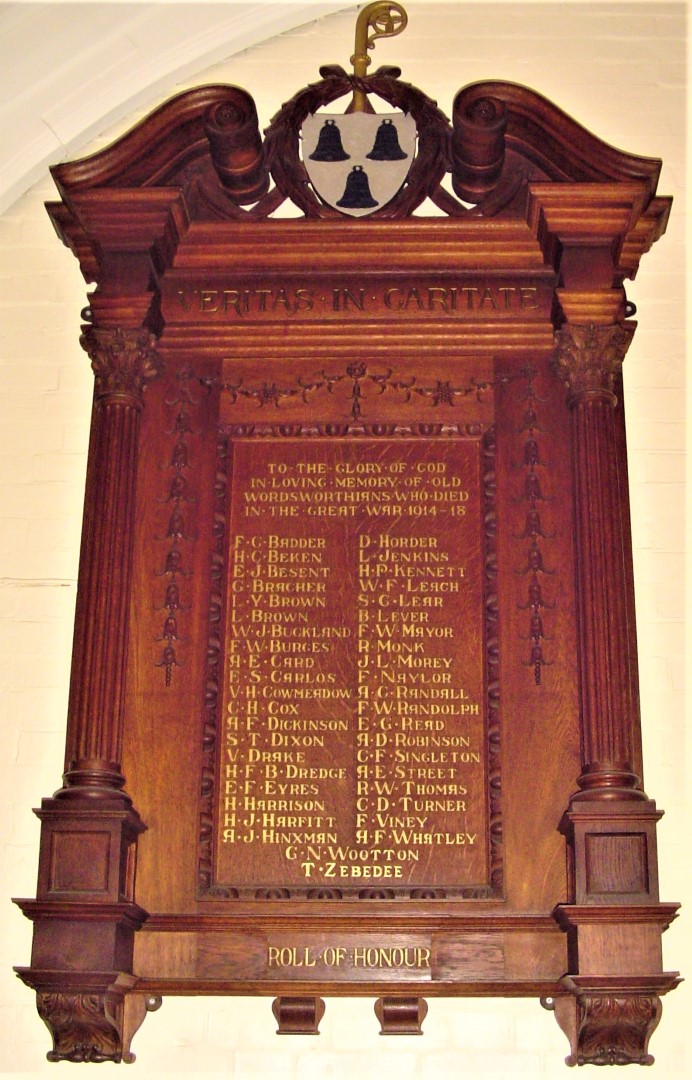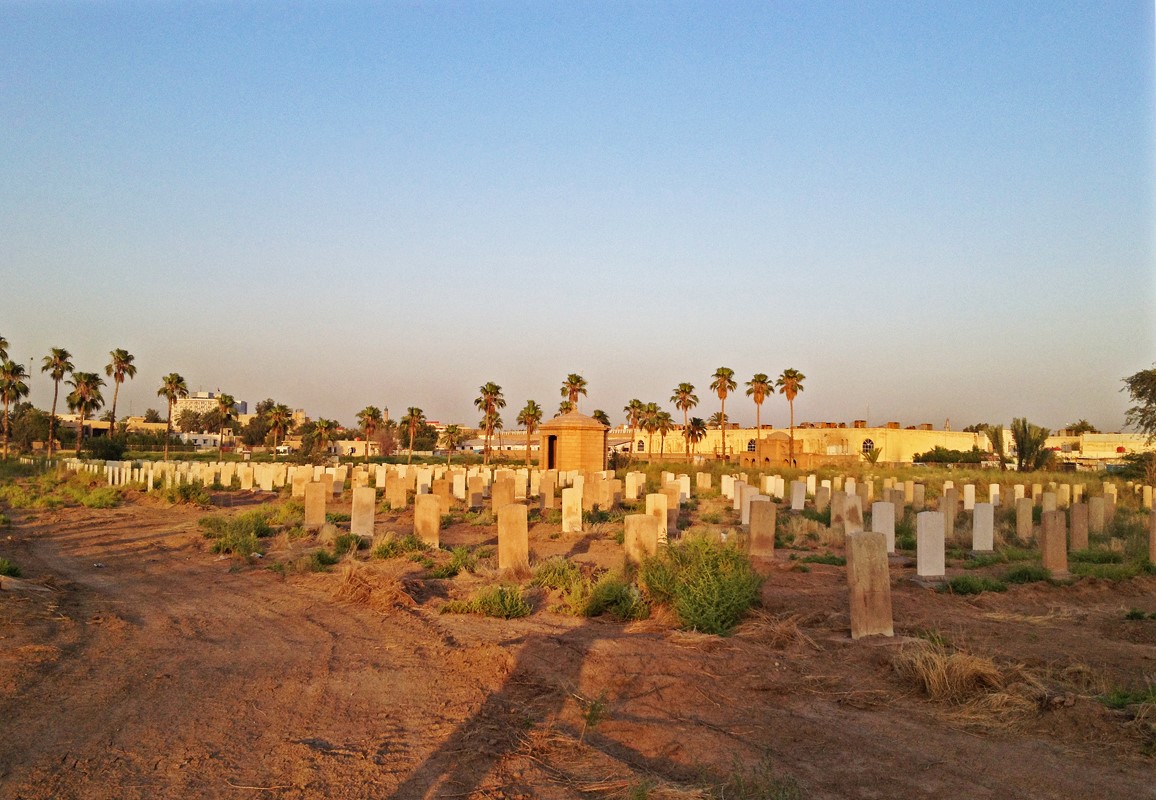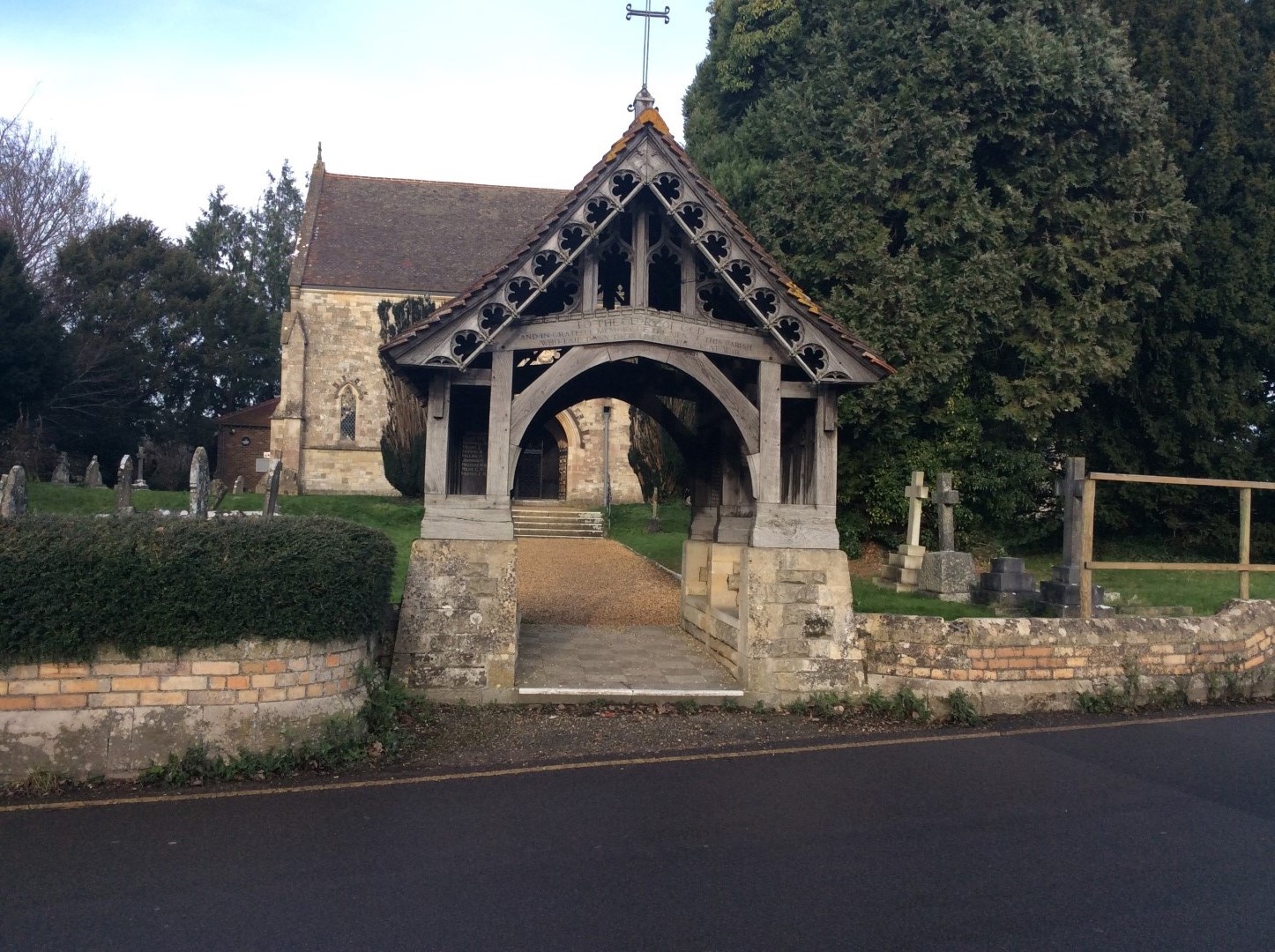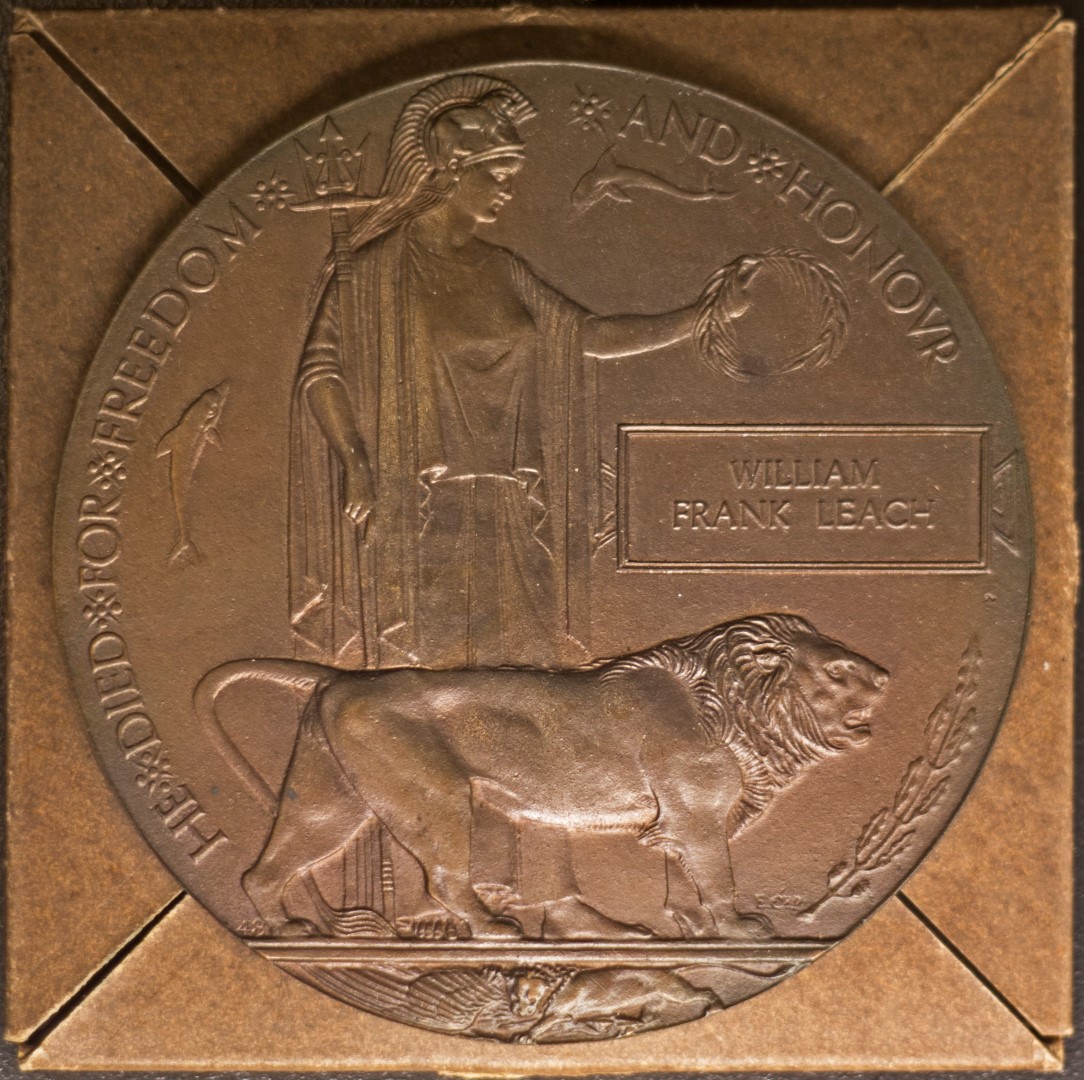William Frank Leach
Regimental Sergeant Major William Frank Leach, Regimental Number 200025, of the 1/4th Hampshire (T.F.) Battalion, died of illness on 2nd May 1918, aged 30, as a Prisoner of War in Nisibin, Turkey, is buried at Baghdad, North Gate Cemetery and is commemorated at Nisibin.
The Leach Family
William (Billy, Will) Leach was born on 17th April 1888, in Salisbury, Wiltshire, to William Leach and Alice Mary (née Sawkins). He was baptised at St. Thomas’ Church, in the centre of Salisbury, on the 9th July that year. In the census of 1891, the family were living at 41, Castle Street, Salisbury, above the grocer’s shop where William senior worked as a grocer, wine merchant and a tallow chandler. William is recorded as being an employer so in all likelihood, he was the owner of the business. Before him, the business was run by his father (Billy’s grandfather), also called William. He was not native to Salisbury but had been born in King’s Langley, Hertfordshire. He arrived in Salisbury in his mid-twenties and set up the business as a tea dealer. He must have been a well-respected businessman as he was elected Mayor of Salisbury in 1881. He died in 1884, just four years before his grandson was born. The year before he died, in 1883, he took his son, Billy’s father, as a partner in the business. William had three older sisters in 1891, Maud Sarah (7) a scholar, Alice Winifred (6) a scholar, and Dorothy (4), surprisingly also listed as a scholar. William Frank was just two years of age. There was a baby sister too, Marjory, who was just 10 months old. All of the family had been born in Salisbury. They were not the only inhabitants of the flat above the shop. Sarah Leach (42), Billy’s aunt was living with them. She is recorded as living on her own means. Sarah had also been born in Salisbury. Apart from the family there were three other single women making up the household. Two of them, Emily Ann Kitley (33) from Heytesbury, Wiltshire and Elizabeth Kate Daniel (15) from Amesbury, Wiltshire were given the job description of nurse, although Elizabeth was also recorded as being a domestic servant. The third female was a general domestic servant called Bessie Louisa Worsded (19) from Haxon, Wiltshire. Unfortunately there is no way of knowing whether the term nurse was as we would understand it today, or a nursery nurse, employed to look after the children. William Leach senior must have been making a good living from the shop at this time in order to be able to employ three people within the household. By the next census of 1901 the family had moved out of the centre of Salisbury to Bemerton. Now a part of Salisbury, in the 1900s it still would have been a separate village. They were residing at 2, Stanhope Villas and William senior now gave his occupation as a grocer’s traveller, perhaps what we would understand today as being a travelling salesman. The children were all still with them. Maud was now working as a pupil teacher at an elementary school and there had been a new addition to the family, Mary aged 3. Aunt Sarah was no longer with them. She was now residing in Ipswich with her sister and brother-in-law, James Haskell. There were no longer any servants with the family.
William’s grandfather, William Leach, Mayor of Salisbury Photograph courtesy of Peter William Lednor
William attended Bishop Wordsworths school in Salisbury. The school had been founded in 1889 by Bishop John Wordsworth and until 1928 was a school for both boys and girls. In 1905, when William may still have been at the school it became a grammar school, as it remains today. Fees were charged for the pupils. The Headmaster from 1890 until 1928 was Mr. Reuben Bracher. The Salisbury and Winchester Journal and General Advertiser, for Saturday 27th October 1900, tells us that William was one of three students at the school who were successful in their examinations, and were awarded a county minor scholarship. After completing his studies at Bishop’s, William became a pupil teacher at Amesbury Mixed School in the nearby town of Amesbury. He was then appointed as an Assistant Teacher at the same school. In preparation for his teaching career, William took Oxford Senior exams in Chemistry, Magnetism, Electricity, Sound, Light and Heat, and a drawing exam in Brushwork. He took his Preliminary Examination for the Certificate in April 1907 as well as the Archbishops’ Examination for Admission for which he was awarded a third class pass. By the time of the 1911 census William had left home to pursue his teaching career and the family had moved again to 1, Montgomery Terrace, Bemerton. William senior was now employed as a grocer’s clerk, a considerable change in fortune from owning his own grocery twenty years earlier. The girls were all still single and living with the family. Maud was now an assistant teacher in a County Council school, and both Dorothy and Marjery (note a different spelling of Marjory from the 1891 census) were milliners at a draper’s shop. Mary was still at school.
William Leach, Training and Teaching
William Frank had left Bemerton for Winchester Training College where he studied from 1907 to 1909. From The Wintonian magazines 1908-1910, we learn that Billy represented the Juniors against the Seniors in the cricket match, in his first year at College. He was mentioned for carrying his bat for 21 in their win over the Seniors. He was also the First XI goalkeeper. The magazine, in the section ‘Football Notes’, states:
Leach, the goalkeeper, is still the same as ever although he has his peculiarities, viz: he kicks the ball when there is plenty of time to pick it up, and he picks the ball up with about four men on him, consequently he gets ‘laid out’ occasionally. Again to my way of thinking, he hasn’t acquired the knack of running out to meet the ball, a very important point in goalkeeping.
William also got a mention in the magazine in the Territorial Notes section, where his promotion to Lance-Corporal was reported as was the fact that he had won the Battalion Cup as the best shot. During the time that William was at College there was a pageant in Winchester. This was quite an extravaganza involving the whole city. Many of the students got involved.
While several parts of varying importance were undertaken by members of the College undoubtedly our most prominent part was that of the black-robed Benedictine monks from St. Swithun’s Monastery. Into this work, about half the first year, and almost the whole of the second year students threw themselves with great keenness, and contributed thereby a very distinctive feature to the Pageant.
William was one of those monks. At the end of his two years at College, William was given a Grade B for Teaching and Music and Grade C for Drawing. His Student Record notes the fact that he was omitted from the Archbishops’ Examination at the end of the first year, but no reason for this is given. In his final exams William achieved a Class 1 pass, and was placed second in the Progress Prize, having been placed 24th in the order of merit at the end of the first year and finishing the second year as 9th in his year group. William took Chemistry as an optional subject in his final exams. In 1911 William was living and teaching in Winchester. He was boarding with George Wheeler and his wife, Bessie Louise, at 2, Alswitha Terrace. In all likelihood George Wheeler was a family friend. Like William, George was from Salisbury and gave his occupation as a traveller in grocery provisions, wines and spirits. He was married to Bessie who had been the Leach’s domestic servant in 1891. We know that William was still single and working as a schoolmaster. He was teaching at St. Thomas’ Elementary School. This was the school where students at the College did their teaching practice lessons. It would have meant that William retained close links with the College. It was also an indication that William was considered to be a good teacher as he would have been required to give demonstration lessons to the students from the College. We know from a newspaper obituary that while he was teaching in Winchester, William took an active part in the community. He was a member of the Conservative Club, played in the Whist League, was the treasurer of The Winchester and District Teachers’ Association (from 1909 -1914) and was a member of the local football club.
The Outbreak of War
Like other students at Winchester Training College, William enlisted in the Volunteer Force when he first arrived at College in 1907, but in 1908 the Volunteer Force became the Territorial Force with rules that allied more closely with the regular army. His enlistment date at college was 17th September 1907. He must have remained as a reservist as he was mobilized at the outbreak of war in August 1914. In an obituary it states that William was training on Salisbury Plain with the 4th Hampshire Regiment when war broke out and he was sent to India. ‘A’ Company of the 1/4th Hampshires formed part of the Indian Expeditionary Force. By the end of 1914 William was in Mesopotamia where the aim, initially, was to secure British oil interests, but once that had been achieved the Force advanced further into Iraq towards Baghdad. At some point during this time William sent a Christmas card to his sister Dot (Dorothy). Although Dorothy wrote on the card that it was the last one they had from Billy, he was able to send home basic communications on postcards from his time as a prisoner of war.
Christmas card in the collection at the Hampshire Regimental Museum
After an unsuccessful attempt to capture Ctesiphon from the Turkish troops, the Expeditionary Force, under the command of Major-General Townshend, retreated to Kut-al-Amara. The Turkish Army pursued them and surrounded them in Kut. There they remained besieged from December 1915 until the end of April 1916. Attempts by a relief force failed to reach them, at the cost of great loss of life, including many 1/4th Hants and some others who had also trained at Winchester Diocesan Training College. Conditions inside the besieged town, for the British and Indian forces and the civilians who had chosen to remain in the town, were appalling. By the time they surrendered many men had died, some from enemy bombardment and sniper fire, or by disease or starvation. Those who had survived were in poor physical shape, many suffering from debilitating illnesses and none in any condition to undertake the trek forced upon them by their Turkish captors.
Prisoner of War
As a Regimental Sergeant Major, William would have been amongst the most senior ranked soldiers on the long march into captivity. The Turkish Army had split the Commissioned Officers from the other ranks, which was one of the reasons given after the war for the atrocious treatment that was meted out to the ordinary soldiers by the Turkish army and their hired Arab escorts. William first comes to our attention as an important figure during the ordeal of the march. He wrote a letter about the shocking treatment of Private Woods, a fellow 1/4th Hampshire man.
During the march on the night of June 12th-13th Pte Woods who had considerably fallen away through weakness, fell out on the march. On arriving at the rest camp on the morning of the 13th Pte Woods was missing. After about an hour after arrival it was reported to me that a man of the Hants Regt was lying helpless close to where the camels were unloaded. I had the man fetched and on being brought to me found him in an utterly exhausted condition. His belt had been stolen by the escort, and his shirt was very much torn. His body was one mass of scars and bruises which he accounted for by the brutal treatment he had suffered. He was flogged and kicked and hit with rifles and was absolutely unable to pick out or recognise the man who had treated him thus owing to his weak condition. I took him with Coy Q M Sgt Bogie 2 (acting as interpreter) to Kashmi Effendi, and showed him how the man had been treated, but owing to the man not being able to pick his assailants no visible sign of notice seemed to be taken. When we marched again later in the day I made arrangements for Pte Woods who was still very exhausted to ride on the camels. On June 14th he was left at the Store Depot with other sick, some of whom joined us on June 18th, when they reported his death to me. I largely attribute his death to the harsh treatment he received.
19.6.16
Signed Regt Sgt Major
1/4th Hants Regt
William was obviously trying to do his best for his men under extremely difficult circumstances and his frustration at his inability to hold people to account for the treatment suffered by Pte. Woods is apparent in the letter. William did his best to record the distances that they had to march and the conditions they were enduring.
Many of the prisoners who survived the gruelling march were put to work on building the Baghdad Railway. They were split up between a large number of different camps in Turkey and Iraq. We know that William spent time at Nisibin (now Nusaybin on the modern Turkish-Syrian border). He was not always at the same camp throughout his captivity. In Mrs Bowker’s Fund Ledger he is recorded at Afion Kara Hissar, Yarbaschi and Adano. Mrs Bowker was a widow whose husband, Lieutenant-Colonel Bowker of the 1/4th Hampshires had died at the battle of Umm-el- Hanna. She set up a fund, which she called the Comforts Fund, to provide for the prisoners of the Turks and sent out parcels of warm clothing and blankets to see them through the winter weather, food and other items such as playing cards and New Testaments. She adopted William herself, giving her address as Longparish, Hampshire. She has William’s measurements in her Ledger and records him as being 5′ 10” with size 8 shoes. It speaks volumes about their treatment at the hands of the Turks that they needed to be provided with necessities such as trousers and blankets.
William Leach’s notebooks are held at The Royal Hampshire Regimental Museum. They record the minutiae of life as a prisoner of war. As a senior Non-Commissioned Officer William would have been one of the highest ranking soldiers in the camp. He wrote of ‘time spent in the office’ and kept accounts as well as a record of hospital admissions and deaths. William was responsible for administrative tasks such as the distribution of letters, parcels, clothing, a task which he carried out very efficiently according to Regimental Sergeant-Major Long, who filled the same role as William but for the Oxfordshire and Buckinghamshire Light Infantry. He also mentions how popular William was, not only amongst the Prisoners, but also with the Germans and Turks with whom he came into contact.3 He also moved from camp to camp and an obituary records him as being employed in visiting the P.O.W. camps in Turkey. His last postcard home to his parents spoke of having just completed a 400 mile journey. From letters written after his death it is clear that William worked tirelessly on behalf of the other prisoners, and was universally liked and respected.
Tributes to William Leach
Those from the 1/4th Hampshires who were lucky enough to return home safely were treated to a ‘welcome home’ dinner in the Guildhall in Winchester. At the dinner they were addressed by Major Footner, who said;
I suppose in the whole of Turkey there was no British Officer or man who did not know Sergeant-Major Leach, at any rate by name and reputation, for the work he did for prisoners of war. 4
William died of typhus on the 2nd May 1918 at Nisibin. Accounts of his funeral testify to the high regard in which William was held. Sergeant-Major Long who helped at the funeral comments;
The funeral was the best conducted one that I had witnessed as a prisoner of war, and several Germans attended. Sergeant-Major Leach won respect and popularity by his unfailing courtesy, willingness to help others, and hard work on behalf of the prisoners at Nisibin, from captives and captors alike. His going was a sad loss to the British community at Nisibin and to all the little groups of Englishmen in isolated camps for miles around. 5
An account of his death was written in a letter to William’s father on 4th May 1918, by Captain Puri, a Sikh Havildar.6 The date given for his death in this account differs from the official records.
I am very much aggrieved to tell you of the demise of your noble son, on the morning (9am) of 26 April. He died of typhus fever. During the earlier part of his sickness I was not here but one of my assistants, Mr Newbold, attended him. During the latter part of his illness however I came back and did what I could and what was possible under the circumstances. He was buried on the morning of 27 April. I, Captain Osmond from next Section, a good many sergeants and over 100 Englishmen and Indians attended his funeral Loss of your son has been much felt by all our prisoners here. He was universally respected…7
William’s family received a letter from Private Edward Williams, telling of his death and funeral:
Letter from the family archive of Mrs Barbara Eyles
Captain Puri wrote to the Officer Commanding the 1/4th Hants about William Leach’s service as a prisoner of war. In his letter he says;
He was of very great help to me in looking after the interests of both British and Indian prisoners of war in Rasal-Ain and Nissibin districts in Turkey. He was very untiring in his efforts to look after the men. He had to do a lot of travelling. He was very tasteful, straightforward and universally respected both by British and Indian Prisoners of War. His loss was a great loss to our prisoners in their captivity. I can say that he contracted the disease while looking after and trying to improve the conditions of certain men and his death was directly attributable to the performance of his duties, which he had most willingly and ungrudgingly undertaken. I recommend him very strongly.
William did get a mention in dispatches. His mother received a letter dated 17th January 1921 that said that he had been brought to the notice of the Secretary of State for War, and published in the Fourth Supplement to the London Gazette dated 30th January 1920
for valuable services rendered whilst a prisoner of war. I am to express to you the King’s high appreciation of these services and to add that His Majesty trusts that their public acknowledgement may be of some consolation in your bereavement.
Local newspapers published tributes to William.
An extract from Major Footner’s letter to Esme Bowker from the archives at The Royal Hampshire Regimental Museum
The letter continued:
I will write again if I can get any more particulars. Will you be so good as to write to his relations. I do not think he was married? Tell them how sorry I and all the officers and men of the Regiment are because of his death. I suppose that he was the best known Officer or man among the British Prisoners in Turkey, and was certainly one of the most respected and best loved. I can certainly say that all the officers who have come in contact with him have respected and liked him.
Mrs Bowker passed a copy of the letter on to the family where it remained with the other tributes paid to their much loved Billy.
William was buried at Nisibin but then his body was moved to Baghdad North Gate Cemetery after the war. It lies in an unmarked grave today as it was not possible to identify the individuals when they were moved from Nisibin. He is commemorated at Nisibin and also at King’s School, Winchester, which holds the Memorial from St. Thomas’ School, Bishop Wordsworth School, Salisbury and at St. John’s Church, Bemerton, Salisbury.
Above: Leach’s Signature from the Students’ Register at the Hampshire Record Office photograph by Dee Sayers.
Right: William’s ‘Death Penny’ (properly, Memorial Plaque, 12cm diameter bronze) which would have been presented to his family by the War Office, now in the archives at The Royal Hampshire Regimental Museum.
William Leach made a profound impression on all those who came into contact with him as a prisoner of war in Turkey. As with many young men of his generation his life was tragically cut short.
One Hundred Years On
On the final weekend of June 1918 we officially launched our project at the annual Winton Reunion taking place at The University of Winchester. One of the attendees that weekend was the great niece of William Leach. She too had trained at the same institution as her great uncle, but in her time it was known as King Alfred’s College. She had spent her three years unaware that a memorial existed in the chapel (then known as the Winton Room).
At the end of the reunion weekend she returned home and took a look at our website, after which she contacted us to add more to the story of William Leach. Her grandmother was Marjory Leach, the second youngest of the five Leach children. The story is best told in her own words:
‘As I was growing up I heard stories of Billy, her dearly loved brother, and to this day can feel the sadness she felt for his loss. When he was killed all his sisters were given a gold ring by his parents with the inscription inside, “In memory of dear Billy—April 1918”. Both my sister and I are in possession of one of these rings that we have worn since 1974 when my grandmother died.’
Researcher and Author: Dee Sayers
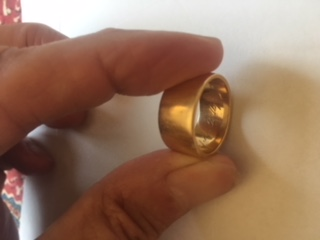
Footnotes
- Extract from the Kut Death March – winkleighonline
- Company Quarter Master Sergeant Andrew Bogie Winchester Training College student 1902-1904.
- From The Hampshire Regimental Journal quoted by Crowley.
- Other Ranks of Kut by Flight-Sergeant Long quoted by Crowley.
- Ibid.
- Havildar is the Indian Infantry rank equivalent to a Sergeant in the British Army.
- Captain Puri Letter quoted by Crowley.
Sources
Ancestry (2018). Home page. [online] Available at: www.ancestry.co.uk [Accessed 2018]. Bishop Wordsworth School (2018). BWS – 126 years of history in one webpage. [online] Available at: http://www.bws-school.org.uk/The_School/History/ [Accessed 2018]. British Newspaper Archive (2018). Salisbury and Winchester Journal – Saturday 27 October 1900, p.6. [online] Available at: https://www.britishnewspaperarchive.co.uk/viewer/bl/0000361/19001027/106/0006 [Accessed 2018]. Commonwealth War Graves Commission, (2018). Home page. [online] Available at www.cwgc.org/ [Accessed 2018]. Crowley, P. (2016). Kut 1916: the forgotten British disaster in Iraq. Stroud: The History Press. Sayers, D. Location photographs. Vickers, J. University of Winchester Chapel Memorial Rail image. The William Leach Collection (Various). Records of RSM W.F. Leach including the records of Mrs. E. Bowker [documents, notebooks, photographs and artefacts] The Royal Hampshire Regimental Museum, Winchester. Personal testimony from Mrs Jane Riddell https://www.winkleighonline.com/wmc/level3/kutdeathmarch.htm Personal testimony from Peter William Lednor, grandson of Marjory and great-nephew of William.
| University of Winchester Archive “ Hampshire Record Office | ||
| Reference code | Record | |
| 47M91W/ | P2/4 | The Wintonian 1899-1900 |
| 47M91W/ | P2/5 | The Wintonian 1901-1902 |
| 47M91W/ | P2/6 | The Wintonian 1903-1904 |
| 47M91W/ | P2/7 | The Wintonian 1904-1906 |
| 47M91W/ | P2/8 | The Wintonian 1905-1907 |
| 47M91W/ | P2/10 | The Wintonian 1908-1910 |
| 47M91W/ | P2/11 | The Wintonian 1910-1914 |
| 47M91W/ | P2/12 | The Wintonian 1920-1925 |
| 47M91W/ | D1/2 | The Student Register |
| 47M91W/ | S5//5/10 | Photograph of 5 alumni in Mesopotamia |
| 47M91W/ | Q3/6 | A Khaki Diary |
| 47M91W/ | B1/2 | Reports of Training College 1913-1914 |
| 47M91W/ | Q1/5 | Report and Balance Sheets 1904- 1949 |
| 47M91W/ | R2/5 | History of the Volunteers Company 1910 |
| 47M91W/ | L1/2 | College Rules 1920 |
| Hampshire Record Office archive | ||
| 71M88W/6 | List of Prisoners at Kut | |
| 55M81W/PJ1 | Managers’ Minute Book 1876-1903 | |
| All material referenced as 47M91W/ is the copyright of The University of Winchester. Permission to reproduce photographs and other material for this narrative has been agreed by the University and Hampshire Record Office. | ||



